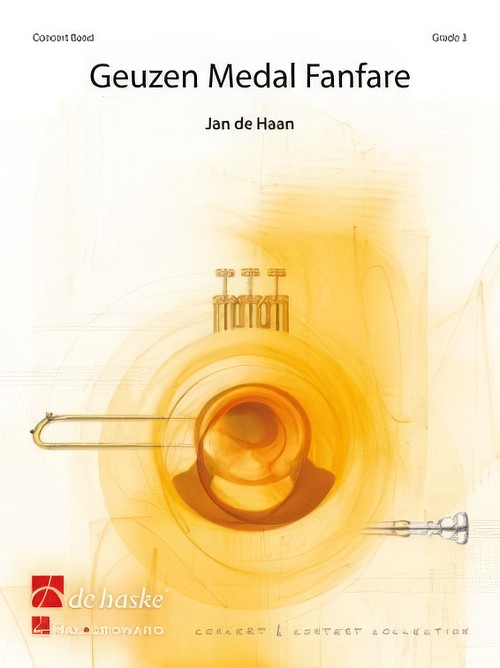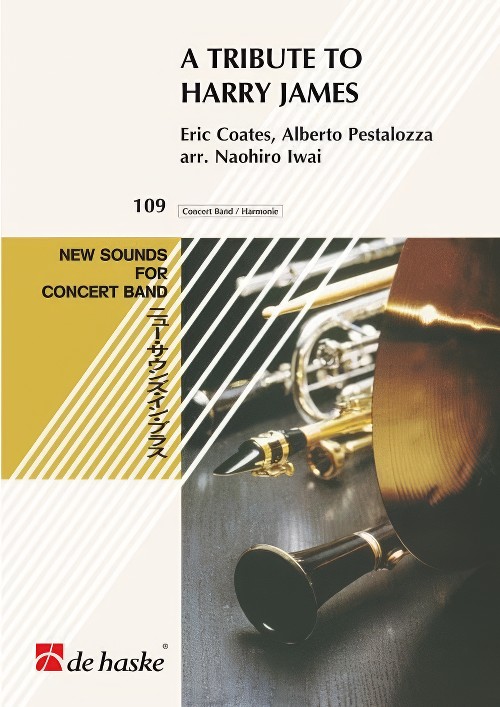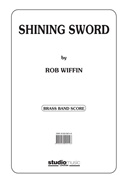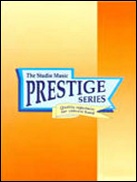Results
-
 £104.99
£104.99Geuzen Medal Fanfare (Concert Band - Score and Parts) - De Haan, Jan
The Geuzen Medal is an annual award given to people or organisations who have found unique ways to further democracy in the world and help eliminate dictatorships, racism, and discrimination. The original Geuzen fought against Spanish imperialism in Holland during the 16th century. During the Second World War a group resisting the Nazis also named themselves De Geuzen. Jan de Haan incorporates Psalm 43, sung by a group of condemned prisoners shortly before their execution in 1943, into Geuzen Medal Fanfare, composed for the 25th bestowal of this special award.Duration: 5:00
Estimated dispatch 7-14 working days
-
 £118.99
£118.99A Tribute to Harry James (Concert Band - Score and Parts) - Coates & Pestalozza - Iwai, Naohiro
Prior to the second world war Harry James was a 'name'. In 1939 this trumpet player/composer founded his own orchestra with which he undertook a series of successful tours. Naohiro Iwai wrote this solo for trumpet with wind band accompaniment as an ode to Harry James, making use of the golden oldies Sleepy Lagoon and Ciribiribin.Duration: 5:45
Estimated dispatch 7-14 working days
-
 £89.99
£89.99Adagio Wind Band Set (Score & Parts)
The Adagio is based on a manuscript that was discovered in the Dresden State Library after the Second World War by Remo Giazotto, a Milanese musicologist who was working on Albinoni's biography at the time. Only the bass line and six bars of melody were found and they probably belonged to the slow movement of a Trio Sonata. In 1945 Giazotti reconstructed the now famous Adagio which has made Albinoni known to a worldwide audience. 0:04:30
Estimated dispatch 7-14 working days
-
 £84.99
£84.99Bundeslied Wind Band Set (Score & Parts)
The melody of Bundeslied originates from Mozart's' Frimaurerkantate (KV62) from 1791. However research has shown evidence that it was probably composed by Johann Holzer, a freemason brother of his, but there is no definite evidence for this. Following the Second World War this melody was used as the basis for the new Austrian national anthem. Micheal Bilkes has adapted this beautiful, stately hymn for concert band. The result is a captivating work for both performers and audience.
Estimated dispatch 7-14 working days
-
 £204.99
£204.99Credentium Wind Band Set (Score & Parts)
A spectacular dive via an extended chromatic scale immediately submerges us in a charged and somewhat archaic-feeling atmosphere. Trumpets, horns and trombones resound in rhythmic patterns, buttressed by restless motifs in the percussion. A second theme, in the woodwinds, begins much calmer but is quickly pushed aside by that same brass offensive. This introduction is the musical expression of the sometimes tumultuous early history of the town of Peer in Belgium. It closes with a D scale played over two octaves and repeated three times, symbolizing the church steeples that dominate the townscape. Peer has the credentials of a town, and people should know about it.There follows a rhythmic, turbulent passage: in the course of history, Peer has not been spared the ravages of war, arson, occupation, epidemic and other evils. In contrast, a slow, pastoral, lyrical part expresses the periods of peace and prosperity the town has known, as well as the serene geographic setting that still characterizes the place. Various instruments in groups are developed in solo style while the accompaniment displays vast, painterly images of sound. Now and then an exotic intonation is heard: a variety of peoples and cultures have left their mark on the town.This episode of tranquility and peacefulness comes to a sudden end when, via a surprising, almost chaotic transitional passage, we are in effect transported back to our own time. A hopeful, festive march expresses the confidence in the future that the Royal Concert Band of Peer exudes. This confidence is wholly justified: under the direction of conductor Willy Fransen, the 95 members of the concert band have experienced an extended period of good fortune, and the 75 musicians of the youth band - and the 45 little musicians of the mini-band - are involved in thriving operations. 0:13:15
Estimated dispatch 7-14 working days
-
 £54.95
£54.95ELEGY 1944 (Anthem for a Regiment) (from Commemorations) (Trumpet Solo with Concert Band - Score and Parts) - Ellerby, Martin
The fourth movement of Commemorations, this work is a solo cornet or trumpet feature in memory of the Guards Royal Military Chapel's tragic bombing during the Second World War. Duration: 4:10. Recorded on Polyphonic Concert Band CD QPRM158D Legacy of Dreams.
Estimated dispatch 7-14 working days
-
 £49.95
£49.95SHINING SWORD (Programme Concert Band) - Wiffin, Rob
This extended fanfare was written for the Royal Air Force Bomber Command Commemorations in 2002. 'Shining Sword' was a term used to describe the Lancaster Bomber which played such a vital role in the Second World War. (Grade 2.5) Performance time 1'48" (Recorded on QPRM142D FESTIVAL OF MUSIC 2002, Massed Bands of the Royal Air Force)
Estimated dispatch 7-14 working days
-
 £74.95
£74.95ST. CLEMENT'S PRELUDE (Programme Concert Band) - Wiffin, Rob
This prelude has allusions to the nursery rhyme Oranges and Lemons (The Bells of St. Clement's). Following the Second World War St. Clement's has been adopted as the Royal Air Force church, to which this work is dedicated. (Grade 3+) Performance time 4'28" (Recorded on QPRM142D FESTIVAL OF MUSIC 2002, Massed Bands of the Royal Air Force)
Estimated dispatch 7-14 working days
-
 £124.95
£124.95SWORD AND THE CROWN, The (Prestige Concert Band - Score and Parts) - Gregson, Edward
In 1988 I was commissioned by the Royal Shakespeare Company to write the music for The Plantagenets trilogy, directed by Adrian Noble in Stratford-upon-Avon. These plays take us from the death of Henry V to the death of Richard III. Later, in 1991, I wrote the music for Henry IV parts 1 and 2, again in Stratford. All of these plays are concerned with the struggle for power (the crown) through the use of force (the sword) and they portray one of the most turbulent periods in the history of the British monarchy.This work quickly became established in the mainstream repertoire and has received performances worldwide as well as five commercial recordings and many broadcasts. In 2002 I was approached by the Parc and Dare Band regarding their summer festival and commissioned to do a version for brass band. This was given its first performance in Treorchy Hall by the combined bands of Black Dyke and Parc and Dare conducted by Nicholas Childs.When the Royal Air Force Music Services commissioned me to write a work especially for their British tour in 1991 I immediately thought of turning to this music and transforming some of it into a three-movement suite for symphonic band.The first movement opens with a brief fanfare for two antiphonal trumpets (off-stage), but this only acts as a preface to a Requiem aeternam (the death of Henry V) before changing mood to the English army on the march to France; this subsides into a French victory march, but the English army music returns in counterpoint. Finally, a brief reminder of the Requiem music leads to the triumphal music for Richard Plantagenet, Duke of York, father of Edward IV and Richard III (the opening fanfare transformed).The second movement takes music from the Welsh Court in Henry IV (part 1) which is tranquil in mood; distant fanfares foreboding battles to come are heard, but the folktune is heard three times in different variations and the movement ends as it began with alto flute and gentle percussion.The final movement starts with two sets of antiphonally placed timpani, drums and tam-tam, portraying the 'war machine' and savagery of battle. Trumpet fanfares and horn calls herald an heroic battle theme which, by the end of the movement, transforms itself into a triumphant hymn for Henry IV's defeat of the rebellious forces.- Edward GregsonPerformance time 13'54"Recorded on QPRM117D FESTIVAL OF MUSIC 1991, Massed Bands of the Royal Air ForceRecorded on QPRM120D THE SWORD AND THE CROWN, Central Band of the Royal Air Force'Finale' recorded on QPRM142D FESTIVAL OF MUSIC 2002, Massed Bands of the Royal Air Force)
Estimated dispatch 7-14 working days
-
 £99.00
£99.00Postcards from Tomorrow - Gauthier Dupertuis
During their childhood, some people have the tradition to put their toys, drawings and wishes for the future into a timebox that they bury somewhere to dig up when they are adults. This has inspired Gauthier Dupertuis for the title of this work: Postcards from tomorrow. What wishes would we put in those boxes for the future; what kind of postcards would we send to our grandchildren? To compose this work, Gauthier Dupertuis was also inspired by three pictures that have some symbolic meaning linked to the question above and that give the names to the three movements that make up this piece.The first movement, Abandoned Blockhouses, refers to war and other horrors in the history of humanity, while Pagoda at the Lake, the second movement, was inspired by the pagoda, a religious building whose function is to house the relics of holy people in Asian worship. The third and last movement, Building Bridges, is a call for hope. In July 221, Postcards from Tomorrow was awarded the first prize at the "La Bacchetta d'Oro" international composition contest in Italy.
Estimated dispatch 7-14 working days
